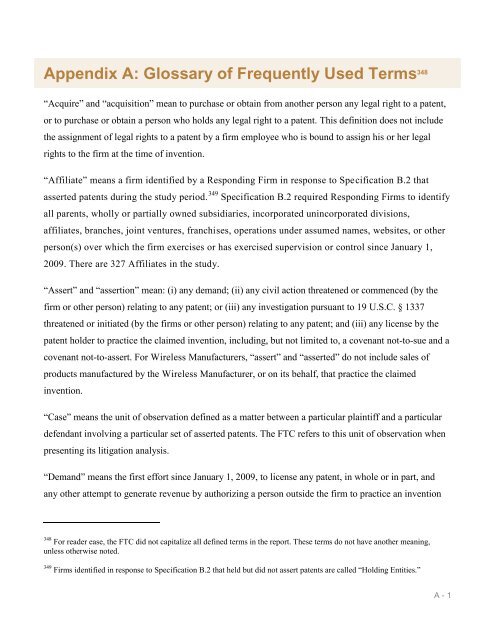Create successful ePaper yourself
Turn your PDF publications into a flip-book with our unique Google optimized e-Paper software.
Appendix A: Glossary of Frequently Used Terms 348<br />
“Acquire” and “acquisition” mean to purchase or obtain from another person any legal right to a patent,<br />
or to purchase or obtain a person who holds any legal right to a patent. This definition does not include<br />
the assignment of legal rights to a patent by a firm employee who is bound to assign his or her legal <br />
rights to the firm at the time of invention.<br />
“Affiliate” means a firm identified by a Responding Firm in response to Specification B.2 that<br />
asserted patents during the study period. 349 Specification B.2 required Responding Firms to identify <br />
all parents, wholly or partially owned subsidiaries, incorporated unincorporated divisions,<br />
affiliates, branches, joint ventures, franchises, operations under assumed names, websites, or other<br />
person(s) over which the firm exercises or has exercised supervision or control since January 1,<br />
2009. There are 327 Affiliates in the study.<br />
“Assert” and “assertion” mean: (i) any demand; (ii) any civil action threatened or commenced (by the<br />
firm or other person) relating to any patent; or (iii) any investigation pursuant to 19 U.S.C. § 1337 <br />
threatened or initiated (by the firms or other person) relating to any patent; and (iii) any license by the<br />
patent holder to practice the claimed invention, including, but not limited to, a covenant not-to-sue and a<br />
covenant not-to-assert. For Wireless Manufacturers, “assert” and “asserted” do not include sales of<br />
products manufactured by the Wireless Manufacturer, or on its behalf, that practice the claimed <br />
invention.<br />
“Case” means the unit of observation defined as a matter between a particular plaintiff and a particular<br />
defendant involving a particular set of asserted patents. The FTC refers to this unit of observation when<br />
presenting its litigation analysis.<br />
“Demand” means the first effort since January 1, 2009, to license any patent, in whole or in part, and<br />
any other attempt to generate revenue by authorizing a person outside the firm to practice an invention<br />
348<br />
For reader ease, the FTC did not capitalize all defined terms in the report. These terms do not have another meaning,<br />
unless otherwise noted.<br />
349<br />
Firms identified in response to Specification B.2 that held but did not assert patents are called “Holding Entities.”<br />
A - 1


